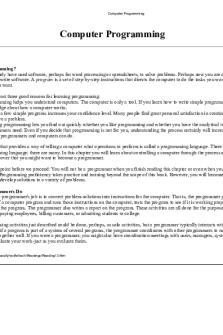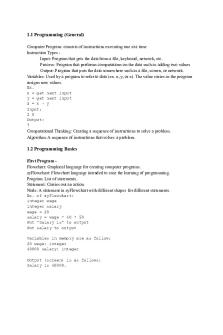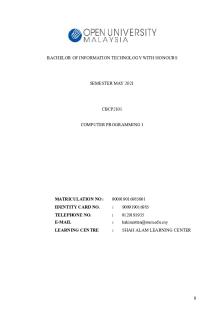Programming Fundamentals Chapter 1 INTRODUCTION TO COMPUTER AND PROGRAMMING PDF

| Title | Programming Fundamentals Chapter 1 INTRODUCTION TO COMPUTER AND PROGRAMMING |
|---|---|
| Author | Quan Nguyen |
| Pages | 31 |
| File Size | 111.2 KB |
| File Type | |
| Total Downloads | 328 |
| Total Views | 939 |
Summary
Chapter 1 INTRODUCTION TO COMPUTER AND PROGRAMMING Programming Fundamentals 1 Chapter 1 Hardware and software Programming Languages Problem solution and software development Algorithms Programming Fundamentals 2 Computer Hardware Input unit Output unit Memory unit ALU CPU Seconda...
Description
Chapter 1
INTRODUCTION TO COMPUTER AND PROGRAMMING
Programming Fundamentals
1
Chapter 1
Hardware and software Programming Languages Problem solution and software development Algorithms
Programming Fundamentals
2
Computer Hardware
Input unit Output unit Memory unit ALU CPU Secondary storage
Programming Fundamentals
3
Input Unit and Output Unit
Input Unit - It obtains information from various input devices and places this information at the disposal of the other units. - Examples of input devices: keyboards, mouse devices.
Output Unit - It takes information that has been processed by the computer and places it on various output devices. - Most output from computer is displayed on screens, printed on paper, or used to control other devices.
Programming Fundamentals
4
Memory Unit
The memory unit stores information. Each computer contains memory of two main types: RAM and ROM. RAM (random access memory) is volatile. Your program and data are stored in RAM when you are using the computer. ROM (read only memory) contains fundamental instructions that cannot be lost or changed by the user. ROM is non-volatile.
Programming Fundamentals
5
ALU and CPU
Arithmetic and Logic Unit (ALU) ALU performs all the arithmetic and logic operations. Ex: addition, subtraction, comparison, etc..
CPU The unit supervises the overall operation of the computer.
Programming Fundamentals
6
Secondary Storage
Secondary storage devices are used to be permanent storage area for programs and data. Examples: magnetic tapes, magnetic disks and optical storage CD. Magnetic hard disk Floppy disk CD ROM etc…
Programming Fundamentals
7
Some terminology
A computer program is a set of instructions used to operate a computer to produce a specific result. Writing computer programs is called computer programming. The languages used to create computer programs are called programming languages.
Software means a program or a set of programs
Programming Fundamentals
8
Machine languages
Machine languages are the lowest level of computer languages. Programs written in machine language consist of 1s and 0s. Programs in machine language can control directly to the computer’s hardware. Example: 00101010 000000000001 000000000010 10011001 000000000010 000000000011
opcode
address parts Programming Fundamentals
9
Machine languages (cont.)
A machine language instruction consists of two parts: an instruction part and an address part. The instruction part (opcode) tells the computer the operation to be performed. The address part specifies the memory address of the data to be used in the instruction.
Programming Fundamentals
10
Assembly languages
Assembly languages perform the same tasks as machine languages, but use symbolic names for opcodes and operands instead of 1s and 0s. LOAD BASEPAY ADD OVERPAY STORE GROSSPAY
An assembly language program must be translated into a machine language program before it can be executed on a computer.
Programming Fundamentals
11
Assembler
Assembly language program
Translation program (assembler)
Programming Fundamentals
Machine language program
12
High-level Programming Languages
High level programming languages create computer programs using instructions that much easier to understand. Programs in a high-level languages must be translated into a low level language using a program called a compiler. A compiler translates programming code into a lowlevel format.
Programming Fundamentals
13
High-level Programming Languages (cont.)
High-level languages allow programmers to write instructions that look like every English sentences and commonly-used mathematical notations. Each line in a high-level language program is called a statement. Example:
Result = (First + Second)*Third
Programming Fundamentals
14
Application and System Software
Two types of computer programs are: application software and system software. Application software consists of those programs written to perform particular tasks required by the users. System software is the collection of programs that must be available to any computer system for it to operate.
Programming Fundamentals
15
Examples of system software
The most important system software is the operating system. MS-DOS, UNIX, MS WINDOWS, MS WINDOWS NT
Many operating systems allow user to run multiple programs. Such operating systems are called multitasking systems. Beside operating systems, language translators are system software.
Programming Fundamentals
16
PROGRAMMING LANGUAGES
Some well-known programming languages: FORTRAN COBOL BASIC PASCAL C C++ Java
1957 1960s 1960s 1971 Structure programming Object-oriented programming
What is Syntax? A programming language’s syntax is the set of rules for writing correct language statements. Programming Fundamentals
17
The C Programming Language
In the 1970s, at Bell Laboratories, Dennis Ritchie and Brian Kernighan designed the C programming language. C was used exclusively on UNIX and on mini-computers. During the 1980s, C compilers were written for other flatforms, including PCs. To provide a level of standardization for C language, in 1989, ANSI created a standard version of C, called ANSI C.
One main benefit of C : it is much closer to assembly language other than other high-level programming languages. The programs written in C often run faster and more efficiently than programs written in other high-level programming language. Programming Fundamentals
18
The C++ Programming Language
In 1985, at Bell Laboratories, Bjarne Stroutrup created C++ based on the C language. C++ is an extension of C that adds object-oriented programming capabilities. C++ is now the most popular programming language for writing programs that run on Windows and Macintosh. The standardized version of C++ is referred to as ANSI C++.
The ANSI standards also define run-time libraries, which contains useful functions, variables, constants, and other programming items that you can add to your programs. The ANSI C++ run-time library is called Standard Template Library or Standard C++ Library Programming Fundamentals
19
Structured Programming
During 1960s, many large softwares encountered severe difficulties. Software schedules were late, costs exceeded budgets and finished products were unreliable. People realized that software development was a far more complex activity than they had imagined. Research activity in the 1960s Structured Programming. It is a discipline approach to writing programs that are clearer than unstructured programs, easier to test and debug and easier to modify.
Chapter 5 discusses the principles of structured programming. Pascal (Niklaus Wirth) in 1971. Pascal was designed for teaching structured programming in academic environments and rapidly became the preferred programming languages in most universities. Programming Fundamentals
20
Object Oriented Programming
In the 1980s, there is another revolution in the software community: object- oriented programming. Objects are reusable software components that model items in the real world. Software developers are discovering that: using a modular, object-oriented design and implementation approach can make software development much more productive. OOP refers to the creation of reusable software objects that can be easily incorporated into another program.
Programming Fundamentals
21
Object Oriented Programming (cont.)
An object is programming code and data that can be treated as an individual unit or component. Data refers to information contained within variables, constants, or other types of storage structures. The procedures associated with an object are referred as functions or methods. Variables that are associated with an object are referred to as properties or attributes. OOP allows programmers to use programming objects that they have written themselves or that have been written by others. Programming Fundamentals
22
PROBLEM SOLUTION AND SOFTWARE DEVELOPMENT
Software development consists of three overlapping phases - Development and Design - Documentation - Maintenance
Software engineering is concerned with creating readable, efficient, reliable, and maintainable programs and systems.
Programming Fundamentals
23
Phase I: Development and Design The first phase consists of four steps: 1. Analyse the problem Analyse the problem requirements to understand what the program must do, what outputs are required and what inputs are needed.
2. Develop a Solution We develop an algorithm to solve the problem. Algorithm is a sequence of steps that describes how the data are to be processed to produce the desired outputs.
3. Code the solution This step consists of translating the algorithm into a computer program using a programming language. 4. Test and correct the program
Programming Fundamentals
24
Phase II: Documentation
Documentation requires collecting critical documents during the analysis, design, coding, and testing. There are five documents for every program solution: -
Program description Algorithm development and changes Well-commented program listing Sample test runs User’s manual
Programming Fundamentals
25
Phase III: Maintenance
This phase is concerned with - the ongoing correction of problems, - revisions to meet changing needs and - the addition of new features.
Programming Fundamentals
26
ALGORITHMS
You can describe an algorithm by using flowchart symbols. By that way, you obtain a flowchart. Flow chart is an outline of the basic structure or logic of the program. Another way to describe an algorithm is using pseudocode.
Since flowcharts are not convenient to revise, they
have fallen out of favor by programmers. Nowadays, the use of pseudocode has gained increasing acceptance.
Programming Fundamentals
27
Flowchart symbols Terminal Input/output
Process
Flowlines
Decision
Programming Fundamentals
28
Example Start
Input Name, Hours, Rate
Calculate Pay Hours Rate
Note: Name, Hours and Pay are variables in the program.
Dislay Name, Pay
End
Programming Fundamentals
29
Algorithms in pseudo-code
You also can use English-like phases to desribe an algorithm. In this case, the description is called pseudocode. Example: Input the three values into the variables Name, Hours, Rate. Calculate Pay = Hours Rate. Display Name and Pay.
Programming Fundamentals
30
Loops
Note: 1. Loop is a very important concept in programming.
Start
2. NUM NUM + 1 means
NUM 4 SQNUM NUM2
Print NUM, SQNUM NUM NUM + 1
old value of NUM + 1 becomes new value of NUM. The algorithm can be described in pseudocode as follows: NUM 4 do
SQNUM NUM2
No NUM> 9? Yes
STOP
Print NUM, SQNUM NUM NUM + 1
while (NUM...
Similar Free PDFs

Computer Programming Laboratory 1
- 10 Pages

Computer Programming python
- 15 Pages

Computer programming viva qus
- 18 Pages

Computer Programming Notes
- 39 Pages
Popular Institutions
- Tinajero National High School - Annex
- Politeknik Caltex Riau
- Yokohama City University
- SGT University
- University of Al-Qadisiyah
- Divine Word College of Vigan
- Techniek College Rotterdam
- Universidade de Santiago
- Universiti Teknologi MARA Cawangan Johor Kampus Pasir Gudang
- Poltekkes Kemenkes Yogyakarta
- Baguio City National High School
- Colegio san marcos
- preparatoria uno
- Centro de Bachillerato Tecnológico Industrial y de Servicios No. 107
- Dalian Maritime University
- Quang Trung Secondary School
- Colegio Tecnológico en Informática
- Corporación Regional de Educación Superior
- Grupo CEDVA
- Dar Al Uloom University
- Centro de Estudios Preuniversitarios de la Universidad Nacional de Ingeniería
- 上智大学
- Aakash International School, Nuna Majara
- San Felipe Neri Catholic School
- Kang Chiao International School - New Taipei City
- Misamis Occidental National High School
- Institución Educativa Escuela Normal Juan Ladrilleros
- Kolehiyo ng Pantukan
- Batanes State College
- Instituto Continental
- Sekolah Menengah Kejuruan Kesehatan Kaltara (Tarakan)
- Colegio de La Inmaculada Concepcion - Cebu











